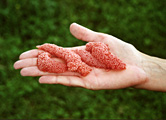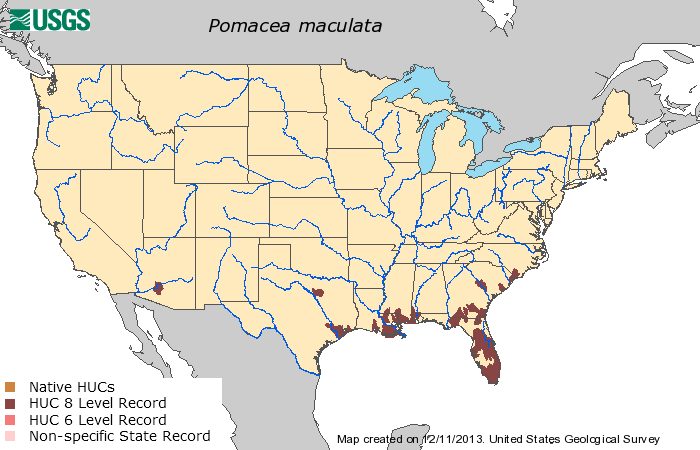|
Pomacea Occulta
''Pomacea occulta'' is a species of freshwater snail in the family Ampullariidae. Previously misidentified as the cryptically similar ''Pomacea maculata'', ''P. occulta'' was differentiated by Yang ''et al.'' in 2019 using DNA barcoding and molecular systematics. Distribution This species has only been identified from invasive Invasive may refer to: *Invasive (medical) procedure *Invasive species *Invasive observation, especially in reference to surveillance *Invasively progressive spread of disease from one organ in the body to another, especially in reference to cancer ... populations in China, so its native region is not known, but would be somewhere in South America. References occulta Freshwater snails Gastropods described in 2019 {{Ampullariidae-stub ... [...More Info...] [...Related Items...] OR: [Wikipedia] [Google] [Baidu] |
Freshwater Snail
Freshwater snails are gastropod mollusks which live in fresh water. There are many different families. They are found throughout the world in various habitats, ranging from ephemeral pools to the largest lakes, and from small seeps and springs to major rivers. The great majority of freshwater gastropods have a shell, with very few exceptions. Some groups of snails that live in freshwater respire using gills, whereas other groups need to reach the surface to breathe air. In addition, some are amphibious and have both gills and a lung (e.g. ''Ampullariidae''). Most feed on algae, but many are detritivores and some are filter feeders. According to a 2008 review of the taxonomy, there are about 4,000 species of freshwater gastropods (3,795–3,972). At least 33–38 independent lineages of gastropods have successfully colonized freshwater environments. It is not possible to quantify the exact number of these lineages yet, because they have yet to be clarified within the Cerit ... [...More Info...] [...Related Items...] OR: [Wikipedia] [Google] [Baidu] |
Ampullariidae
Ampullariidae, commonly known as the apple snails, is a family of large freshwater snails, aquatic gastropod mollusks with a gill and an operculum. These snails simultaneously have a gill and a lung as functional respiratory structures, which are separated by a division of the mantle cavity. This adaptation allows these animals to be amphibious. Species in this family are considered gonochoristic, meaning that each individual organism is either male or female. Systematics and taxonomy Ampullariidae belongs to the superfamily Ampullarioidea, and is also its type family. It comprised two subfamilies according to the taxonomy of the Gastropoda by Bouchet & Rocroi, 2005, which followed the classification proposed by Berthold (1991), including Ampullariinae Gray, 1824, and Afropominae Berthold, 1991. The current classification accepted by WoRMS includes Ampullariinae and Pomaceinae Starobogatov, 1983. Genera Ampullariidae are probably of Gondwanan origin, and the divers ... [...More Info...] [...Related Items...] OR: [Wikipedia] [Google] [Baidu] |
Cryptic Species
In biology, a species complex is a group of closely related organisms that are so similar in appearance and other features that the boundaries between them are often unclear. The taxa in the complex may be able to hybridize readily with each other, further blurring any distinctions. Terms that are sometimes used synonymously but have more precise meanings are cryptic species for two or more species hidden under one species name, sibling species for two (or more) species that are each other's closest relative, and species flock for a group of closely related species that live in the same habitat. As informal taxonomic ranks, species group, species aggregate, macrospecies, and superspecies are also in use. Two or more taxa that were once considered conspecific (of the same species) may later be subdivided into infraspecific taxa (taxa within a species, such as bacterial strains or plant varieties), that is complex but it is not a species complex. A species complex is in most cas ... [...More Info...] [...Related Items...] OR: [Wikipedia] [Google] [Baidu] |
Pomacea Maculata
''Pomacea maculata'' is a species of large freshwater snail with an operculum, an aquatic gastropod mollusk in the family Ampullariidae, the apple snails. Common name of its synonymous name ''Pomacea insularum'' is the island applesnail. Together with ''Pomacea canaliculata'' it is the most invasive species of the family Ampullariidae. It is considered as about the 58th worst alien species in Europe. Distribution The indigenous distribution of ''Pomacea maculata'' is South America. ''Pomacea maculata'' is reported from Argentina, Brazil, and Bolivia and it probably occurs in Uruguay and Paraguay. The type locality is the Río Paraná, which joins the Río Uruguay just above Buenos Aires, forming the Río de la Plata. The area between the Paraná and the Uruguay is the Argentine province of Entre Ríos, the southern part of which is marshy, with channels connecting the Paraná and the Uruguay. Non-indigenous distribution North America The initial introductions in th ... [...More Info...] [...Related Items...] OR: [Wikipedia] [Google] [Baidu] |
DNA Barcoding
DNA barcoding is a method of species identification using a short section of DNA from a specific gene or genes. The premise of DNA barcoding is that by comparison with a reference library of such DNA sections (also called "sequences"), an individual sequence can be used to uniquely identify an organism to species, just as a supermarket scanner uses the familiar black stripes of the UPC barcode to identify an item in its stock against its reference database. These "barcodes" are sometimes used in an effort to identify unknown species or parts of an organism, simply to catalog as many taxa as possible, or to compare with traditional taxonomy in an effort to determine species boundaries. Different gene regions are used to identify the different organismal groups using barcoding. The most commonly used barcode region for animals and some protists is a portion of the cytochrome ''c'' oxidase I (COI or COX1) gene, found in mitochondrial DNA. Other genes suitable for DNA barcoding ar ... [...More Info...] [...Related Items...] OR: [Wikipedia] [Google] [Baidu] |
Molecular Systematics
Molecular phylogenetics () is the branch of phylogeny that analyzes genetic, hereditary molecular differences, predominantly in DNA sequences, to gain information on an organism's evolutionary relationships. From these analyses, it is possible to determine the processes by which diversity among species has been achieved. The result of a molecular phylogenetic analysis is expressed in a phylogenetic tree. Molecular phylogenetics is one aspect of molecular systematics, a broader term that also includes the use of molecular data in taxonomy and biogeography. Molecular phylogenetics and molecular evolution correlate. Molecular evolution is the process of selective changes (mutations) at a molecular level (genes, proteins, etc.) throughout various branches in the tree of life (evolution). Molecular phylogenetics makes inferences of the evolutionary relationships that arise due to molecular evolution and results in the construction of a phylogenetic tree. History The theoretical framew ... [...More Info...] [...Related Items...] OR: [Wikipedia] [Google] [Baidu] |
Invasive Species
An invasive species otherwise known as an alien is an introduced organism that becomes overpopulated and harms its new environment. Although most introduced species are neutral or beneficial with respect to other species, invasive species adversely affect habitats and bioregions, causing ecological, environmental, and/or economic damage. The term can also be used for native species that become harmful to their native environment after human alterations to its food webfor example the purple sea urchin (''Strongylocentrotus purpuratus'') which has decimated kelp forests along the northern California coast due to overharvesting of its natural predator, the California sea otter (''Enhydra lutris''). Since the 20th century, invasive species have become a serious economic, social, and environmental threat. Invasion of long-established ecosystems by organisms is a natural phenomenon, but human-facilitated introductions have greatly increased the rate, scale, and geographic range of ... [...More Info...] [...Related Items...] OR: [Wikipedia] [Google] [Baidu] |
Pomacea
''Pomacea'' is a genus of freshwater snails with gills and an operculum, aquatic gastropod mollusks in the family Ampullariidae, the apple snails. The genus is native to the Americas; most species in this genus are restricted to South America. in the aquarium trade these snails are sometimes called ''Pomacea'' or incorrectly ''Ampullarius'', and in English as "olormystery snail" or "apple snail". Some species have been introduced outside their native range and are considered invasive because of their voracious appetite for plants. Because of this, imports involving this genus are restricted in some regions (including the United States) and are entirely banned in others (including the EU).Dawes, J. (14 January 2013). International Waters: EU Finally Bans Apple Snail Imports.'' Retrieved 4 June 2014 Species Species in the genus ''Pomacea'' include: subgenus ''Effusa'' Jousseaume, 1889 * ''Pomacea baeri'' (Dautzenberg, 1902) * ''Pomacea glauca'' (Linné, 1758) * ''Pomacea q ... [...More Info...] [...Related Items...] OR: [Wikipedia] [Google] [Baidu] |
Freshwater Snails
Freshwater snails are gastropod mollusks which live in fresh water. There are many different families. They are found throughout the world in various habitats, ranging from ephemeral pools to the largest lakes, and from small seeps and springs to major rivers. The great majority of freshwater gastropods have a shell, with very few exceptions. Some groups of snails that live in freshwater respire using gills, whereas other groups need to reach the surface to breathe air. In addition, some are amphibious and have both gills and a lung (e.g. ''Ampullariidae''). Most feed on algae, but many are detritivores and some are filter feeders. According to a 2008 review of the taxonomy, there are about 4,000 species of freshwater gastropods (3,795–3,972). At least 33–38 independent lineages of gastropods have successfully colonized freshwater environments. It is not possible to quantify the exact number of these lineages yet, because they have yet to be clarified within the Cerithi ... [...More Info...] [...Related Items...] OR: [Wikipedia] [Google] [Baidu] |






